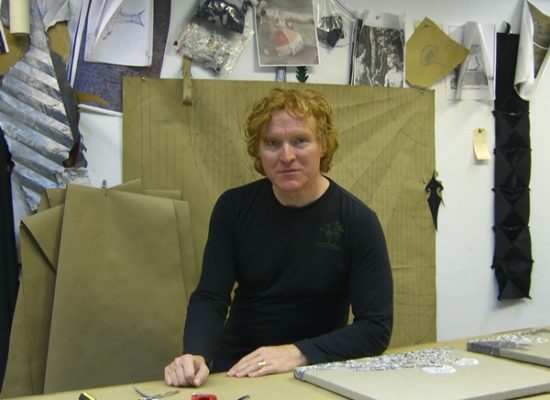Contemporary embroiderer Angelo Filomeno stitches everything from tropical fish to still lifes with skulls and insects. Born in Ostuni, Italy, in 1963, he has lived in New York since 1992. Filomeno’s third exhibition at Galerie Lelong in New York is titled “The House of Magic Affection,” and runs through January 31. Beginning February 12, his work will be on display at the Center for the Arts at Virginia Tech.
artnet News recently spoke with him by telephone to find out more about his work.
When did you know you would become an artist?
I always wanted to be an artist. I remember I was still sitting at the tiny table with my pencils and my mother calling “Come to dinner” and me in my own world still drawing. And I was six.
What kind of artist are you?
I call myself an artist. I am not a fiber artist, not a fabric artist, not a textile artist. My approach is more than the beauty of the material. I see a difference between a craftsman who works with textile and an artist who works with textile. I use the fabric in the way I see the potential of the medium. I call what I do “contemporary embroidery.”
What are you inspired by?
My life inspires my work. Other art inspires my work. I like to see all kinds of art. I go to see shows at auction houses. I go to see jewelry from Turkmenistan, some Greek and Roman, some bronze currencies, bracelets and anklets. When I’m in a project, I go to see different kinds of art. I want to keep my own voice as original as I can. Of course I take inspiration from everybody else but I want to stay in my own voice. I don’t look at contemporary art. I look at textiles sometimes.
You have worked in the garment industry.
I was in the fashion circle in Milan. It was so closed. It was difficult to get into and difficult to get out of. I was caught in Milan because I needed to work. I worked at couture houses after a couple of years. But there was a voice inside of me saying, “Get out.” So, I moved to New York. If I want to change my life tomorrow, I have to go to Tokyo. If I’m going to start from zero, I’m going to change cities.
Your gallerist said you don’t use a computer when you create your images on fabric.
I don’t have any program at the computer. I go into a fabric shop, I buy a piece of fabric that strikes me that day, in that particular mood. I look through my books; I look through my images; I look through my drawings, I look through my cut-outs. I have many cut-outs. Sometimes they are black and white Xerox copies. I put here, I put there, like a collage on the fabric. I do a little composition. Then I embroider one piece; then I do the other one. I see how they come together—this goes lower this goes higher. I have already the divisions because I lay out the design. I take a picture with my mind—this goes here, this goes there. The fish goes next to the skull….It is finished when I see it’s the right amount of work: it’s not too much, it’s not too little. When it looks good for me, it’s finished. If you put too much, you want to puke.
How did you make the Tropical Still Life in Yellow “painting”?
When I did the tropical fishes, I cut out images of the fishes. I took a picture with a camera because I needed to remember where they go. I cannot work with pins on the fabric. Some fishes had four colors up to 10 colors. I needed to see each fish finished before beginning the next fish. If I wanted to change the position of the color, I could do that.
What kind of thread do you use and why do you like it?
Rayon thread. I like that it’s shiny. When I change direction of the thread, with the color I can create an effect, changing how the light hits the thread. So, for example, a couple of fishes have 10 different colors. I can have 30 different colors by changing direction of the thread.
What are you working on now?
Nothing. Until the show goes down, I’m taking a mental rest. I have a project in mind: small pieces, many portraits—busts. They’re old people—3,000 years old.
Do you collect art?
I own some pre-Columbian and African art. I have about 30 pieces from Mexico and Peru, some heads, some little statuettes, utensils, spoons, some flutes. They’re different shapes. I’m fascinated by the forms. I have some pieces of African weapons from the Congo. One piece is embroidered: a blade [Gesso Painting (African Knife) (2014)]. I started with copies from the flea market. You could find a mask for $20. Then my eyes got better. Then I went into head rests and weapons. Then some spoons, some flutes, some figures. But then when you start really going, you have 10 masks and they’re all copies and you want real ones.
If you could buy any piece of art, what would you buy?
If I could buy any piece of art, I would love to have a beautiful, fetish Songye figure.
If you could buy any piece of modern or contemporary art, what would you buy?
Mine!
For more interviews in our artnet Asks series, see artnet Asks: Loris Gréaud and artnet Asks: Artist, Author, and Veteran New Yorker Maira Kalman.
